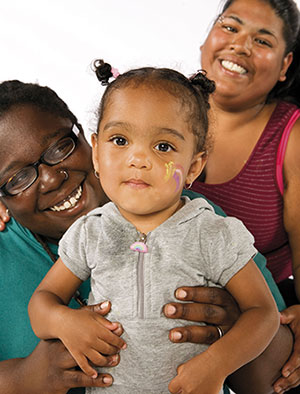4.2 Empowering practice
In Activity 5 you looked at the International Code of Ethics for Social Work, which asserts the need for social workers to consider human rights and social justice as central to practice, alongside an understanding of how individuals interact with their environments. The code argues that social work should be about ‘the empowerment and liberation of people’ and this surely means thinking carefully about terms such as ‘vulnerable’ as descriptions of people whose circumstances are probably not of their choosing and who do have many qualities and resources that are not about ‘vulnerability’. The social work writer Neil Thompson has published widely on what it means to look beyond labels, stereotypes and assumptions in order to promote empowering social work practice. In Activity 8, you will read a short extract from The Social Work Companion (Thompson and Thompson, 2008). This summarises his perspective on how social workers should practise in ways that support the empowerment of people using services and which challenge discrimination.
Activity 8: Anti-discriminatory practice
Read the edited extract below, which is from The Social Work Companion. Make brief notes on the implications for social work practice in Wales
Anti-discriminatory practice
Social work’s clientele is prone to being discriminated against, looked down upon, treated as second-class citizens and thus treated unfairly. It is therefore important that social workers are aware of this and its implications for practice.
In the early days of anti-discriminatory practice, the major focus was on anti-racism. Since then, while anti-racism continues to be a major issue and a central part of anti-discriminatory practice, the focus has been broadened to include discrimination in relation to gender (sexism), age (ageism), disability (disablism), sexual identity (heterosexism) and other such forms of disadvantage. But, of course, in reality, anti-discriminatory practice is even broader than a finite list such as this, as it involves challenging unacceptable practices in relation to any group or individual singled out for unfair treatment.
Anti-discriminatory practice can be seen to involve:
Recognising the significance of discrimination in people’s lives – especially in the lives of those disadvantaged groups we commonly encounter in social work – and how oppressive this can be. Often what appear to be ‘personal’ problems will have their roots, in part at least, in wider social issues of discrimination. For example, many of the difficulties people with mental health problems encounter can be linked with discrimination, such as difficulties in obtaining housing and employment. This can have a significant effect because a lack of housing and employment are significant factors in preventing people with mental health problems dealing with the pressures they encounter.
At a minimum, making sure that our own practice does not reinforce or add to such discrimination. Discrimination is a matter of outcomes, not intentions. That is, if an individual or group is treated unfairly because they are perceived as different, the important issue is the outcome (their being treated unfairly and thus placed at a disadvantage) regardless of the intentions. Much discrimination is unintentional (for example, as a result of unwittingly relying on a stereotype), but that does not alter the fact that it is discrimination and thus unacceptable. Anti-discriminatory practice therefore involves a degree of self-awareness and recognising whether any aspects of our practice unwittingly reinforce discrimination – unlearning assumptions or established patterns of behaviour based on unfairness (for example, being patronising towards disabled people by being too eager to ‘look after’ them, rather than support them in increasing their level of independence).
Trying to tackle discrimination and its adverse effects. The roots of discrimination are very deep indeed and are to be found in cultural formations and structural power relations as well as personal beliefs and attitudes. In this sense, discrimination can be institutional – that is, built into systems and institutionalised patterns of behaviour or assumptions. We cannot therefore expect to remove discrimination altogether without radically altering the social terrain in which it finds such ‘fertile soil’. This is a long-term project and one social work can only play a part in over the years. Our immediate concerns therefore need to focus on more modest aims of doing whatever we reasonably can to prevent, counteract and remove discrimination and the oppression it leads to. For example, in helping a black family deal with and challenge the racism they are encountering in the mental health system, a social worker can play an important part in countering racism for that particular family (which could be a very significant help for them), while also making a small contribution to challenging racism in society more broadly.
Anti-discriminatory practice is a challenging aspect of social work, but failing to address it can be highly problematic. Anti-discriminatory practice is not a specialist approach that only applies in certain circumstances (for example, when a white social worker is working with a black client). Rather, it is a fundamental building block of good practice. It needs to be incorporated across the board and should not be seen as an ‘add-on’ as and when required. As such, it is a major challenge. We therefore have to have a degree of humility in this regard and recognise that we will get it wrong sometimes, but it is vitally important that we rise to the challenge as best we can – both individually and collectively.
Some approaches to anti-discriminatory practice have been confrontational, dogmatic and simplistic and have failed to appreciate the complexities involved. They have also, in doing so, alienated many potential supporters of an anti-discriminatory approach. It is therefore essential that future efforts in this direction are not allowed to fall into this trap. Education and training for anti-discriminatory practice should not be about making people feel guilty for their upbringing, but rather an educational process geared towards helping people ‘unlearn’ the often discriminatory assumptions they have been brought up to believe and to adopt more empowering approaches to working with difference.
(Edited extract from ‘Theories and theorists’ in The Social Work Companion, Thompson and Thompson, 2008)

Discussion
This reading expands on the ideas contained within the international code of ethics you looked at earlier, saying more about what discrimination means in daily life. There is an emphasis on how social workers can use their professional authority to recognise and challenge discrimination and oppression, for example:
We live in a society characterised by various forms of inequality based on class, race, gender, sexuality, disability and age.
Those groups adversely affected by inequality may experience disadvantage and discrimination so that they are treated unfairly.
Social divisions can worsen people’s life chances and undermine health and wellbeing. (You saw some examples in Activity 2.)
There are many specific practice situations where not challenging assumptions could lead to people not getting the service they need – for example, if a social worker believes that a traditional nuclear family is the only ‘right’ kind, then they could respond to a lesbian mother’s requests for help with a teenager’s behaviour with preconceptions about what ‘caused’ the teenager’s difficulties, without getting the full picture of the situation. Or a mental health assessment is carried out in English because the social worker makes the assumption that this is appropriate, without checking out language need, therefore resulting in vital information being missed, or the service user being perceived as uncooperative, or more unwell than is actually the case. In both of these examples, people needing help could be denied it, with potentially serious consequences.
Thompson suggests how social workers can put into practice the professional values of treating individuals with respect and challenging disadvantage and discrimination.
Neil Thompson designed a model for addressing social disadvantage, including discrimination and poverty: PCS analysis (Thompson, 1997, 2006). This has been influential in social work and also fits well with the Rimmer pyramid, which you will read about below. Thompson suggests that individuals are affected by what he calls personal, cultural and structural influences that come together to impact on how we fit into the social world. What Thompson calls ‘cultural’ influences encompass broader shared approaches – such as what is seen as acceptable behaviour. Structural issues refer to the ‘bigger picture’ of how society is organised and include aspects such as government policy and the shape of the welfare state. Thompson calls his PCS model an ‘analysis’ because it is a way of examining different aspects of situations that social workers come across. However, he emphasises that it is about action as well as thought. Social workers, Thompson says, need to do more than understand how individuals are affected by social and other factors; they need to act on this understanding to challenge disadvantage and prejudice. The PCS analysis could be set out in a diagrammatic form (Figure 6), showing how the individual or personal experience is surrounded by cultural and structural influences.

